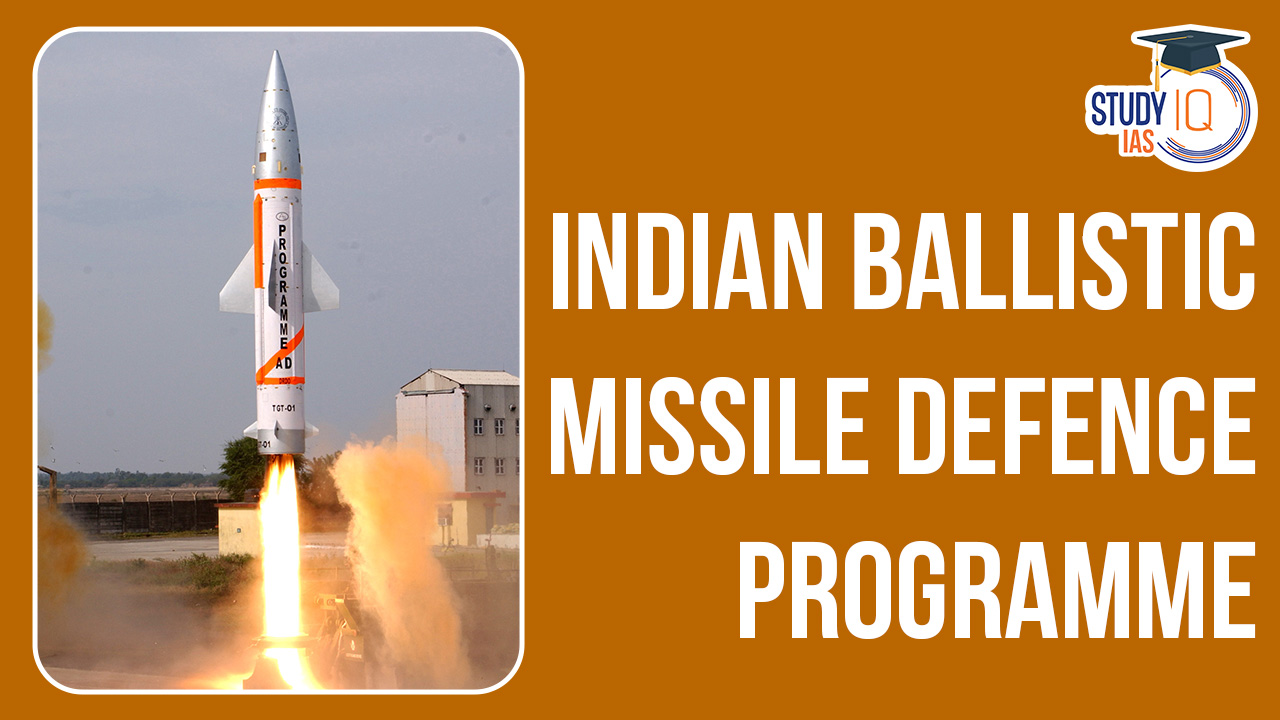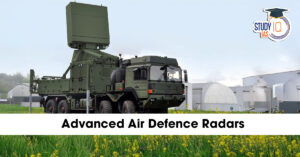Table of Contents
In an era where global security threats continue to evolve, the need for robust defence systems has become paramount. The Indian Ballistic Missile Defence (BMD) Programme stands as a testament to India’s commitment to safeguarding its sovereignty and ensuring the safety of its citizens. This article delves into the significance, evolution, and components of the Indian BMD programme, emphasizing its role in strengthening India’s national security.
Indian Ballistic Missile Defence (BMD) Programme
The Indian Ballistic Missile Defence Program, initiated in 2000 after the Kargil War, aims to develop a multi-layered missile defence system for protection against ballistic missile attacks from countries like Pakistan and China. It includes two interceptor missiles: Prithvi Air Defence (PAD) for high-altitude interception and Advanced Air Defence (AAD) Missile for lower-altitude interception. The system incorporates a network of early warning and tracking radars, along with command and control centers. While successful tests have been conducted, the system has yet to be officially commissioned. The first phase was reported as completed in January 2020, awaiting government approval for installation around the national capital, which may take three to four years.
We’re now on WhatsApp. Click to Join
Background of Indian Ballistic Missile Defence (BMD) Programme
- Early 1990s: India faced the threat of ballistic missile attacks from Pakistan and China.
- August 1995: In response to Pakistan’s acquisition of M-11 missiles from China and growing tensions in the region, India procured six batteries of S-300 Surface-to-Air missiles to protect cities, including New Delhi.
- May 1998: India conducted nuclear tests (Pokhran-II).
- May 1998: Pakistan conducted its first-ever nuclear test (Chagai-I).
- 1999: The Kargil War between India and Pakistan marked the first direct conflict between two declared nuclear powers.
- 31 May 1999: During the Kargil War, Pakistan issued a statement hinting at the possible use of nuclear weapons in response to an escalation of the conflict.
- Development of Anti-Ballistic Missile System: Initiated in late 1999 as a response to heightened tensions during the Kargil War and the absence of a nuclear No First Use policy by Pakistan.
- 2002: Development of the anti-ballistic missile system accelerated after India’s bid to acquire the Israeli Arrow-2 interceptor was vetoed by the United States.
- Phases of the BMD System: Phase-I of the system was designed to intercept missiles up to a 2,000-km range, with plans to extend this range to 5,000 km in Phase-II.
Ballistic Missile Defence (BMD)
Ballistic Missile Defence (BMD) is a sophisticated system designed to monitor and intercept incoming missiles. It employs a network of satellites and radar technology to detect and track these missiles. The data collected by these systems is then analyzed to make decisions regarding which missiles to launch and how many are needed to intercept the incoming missile effectively. Ballistic Missile Defence (BMD) system comprises two tiers with the following key components:
- Advanced Radar System and Early Warning System: Also known as the sensor system, this critical component provides early detection and tracking of incoming missiles.
- Integrated Command and Control Center: Serving as the central nerve center, it coordinates all BMD operations, making real-time decisions and response strategies.
- Agile and Mobile Interceptor Missile Batteries: These batteries are strategically positioned on both land and sea, ensuring swift and flexible responses to missile threats.
What is a Ballistic missile?
Ballistic missiles are high-speed, long-range weapons that follow an unpowered, parabolic trajectory after the initial rocket-powered boost phase. They can carry various warheads and are classified into different ranges. These missiles have been central to international security concerns due to their ability to deliver destructive payloads over significant distances, making them a critical aspect of strategic Defence planning and arms control discussions. Ballistic missile interception can occur in three phases:
- Terminal Phase: This phase involves intercepting the missile during its descent through the Earth’s atmosphere.
- Mid-Course Interception: Intercepting the missile while it’s in flight is the most preferred method.
- Lift-off Phase: Intercepting the missile at its launch point, necessitating advanced radar systems, is another potential interception approach.
Development of Ballistic Missile Defence (BMD) Programme
| Phase 1 | Phase 2 |
| – Initiated in 1999 | – Two new anti-ballistic missiles developed (AD-1 and AD-2) |
| – Involvement of around 40 public and private companies | – Designed to intercept IRBMs (range around 5,000 km) |
| – Key contributors: DRDL, RCI, ASL, HEMRL, and more | – Test trials for these systems expected in 2011 |
| – Phase 1 completed as of April 2019 | – Development similar to THAAD missile (US) |
| – Hypersonic speeds; requires long-range radars | |
| – Phase 2 planned for completion by 2016 |
Sea-based Interception
- DRDO Floating Test Range to support Phase 2.
- INS Anvesh underwent sea trials in September 2021.
- AD-1 missile successfully tested on November 2, 2022.
- Designed for endo-atmospheric and low exo-atmospheric interception.
- AD-1 can intercept incoming missiles from up to 5,000 km.
Laser-based Weapon System
- India plans to develop a laser-based weapon system.
- Intended to intercept and destroy missiles in their boost phase.
- Estimated time for operational use is 10-15 years.
Two-tiered BMD System of India
Prithvi Air Defence (PAD) and Advanced Air Defence (AAD) are two components of India’s Ballistic Missile Defence (BMD) system.
Prithvi Air Defence (PAD)
- Designed for high-altitude interception (exo-atmospheric).
- Intercept missiles at altitudes between 50 – 80 km.
- The interceptor used is Prithvi Defence Vehicle (PDV) with two solid-propellant stages.
- Also known as Pradyumna Ballistic Missile Interceptor.
Advanced Air Defence (AAD)
- Designed for low-altitude interception (endo-atmospheric).
- Intercept missiles at altitudes up to 30 km.
- It utilizes a single-stage solid-fueled missile.
- Also referred to as Ashwin Ballistic Missile Interceptor.
These two components work together as part of India’s BMD system to provide both high and low-altitude interception capabilities against incoming ballistic missiles.
| Component | Type | Specifications and Capabilities |
| Prithvi Air Defence (PAD) | Exo-atmospheric ABM | Intercepting missiles at 50-80 km, Mach 5 speed, 300-5000 km range |
| Advanced Air Defence (AAD) | Endo-atmospheric ABM | Intercepting missiles at 40 km, Mach 4.5 speed, 200 km range |
| Prithvi Defence Vehicle (PDV) | Exo-atmospheric interceptor | Altitude of 180 km, 5,000 km range |
| Swordfish RADAR | Target Acquisition RADAR | Long-range tracking and fire control radar |
| Mission Control Centre (MCC) | Software component | Data processing, target classification, assignment, and more |
| Launch Control Centres (LCC) | Ground-based systems | Compute time to launch, missile preparation |
| Secure Communication Network | Communication | Connects all system elements for data sharing and coordination |
| LRTR (Long Range Tracking Radar) | Radar | Initial target acquisition and tracking (upgraded to 1500 km) |
| Prithvi Defence Vehicle Mark 2 | Exo-atmospheric interceptor | Multi-stage missile for high-altitude interception |
Need of BMD for India
- Deterrence and No First Use Policy: India follows a ‘No First Use’ policy regarding nuclear weapons. A robust BMD system acts as a deterrent, ensuring that even if a nuclear projectile is launched by an enemy state, India has the means to intercept and neutralize it, avoiding a situation where it cannot respond.
- Non-State Threats: There have been concerns about radicalized non-state actors attempting to acquire missile technology. A BMD system provides a shield against missile attacks initiated by such groups, reducing the risk of mutual destruction.
- Hostile Neighbors: India shares borders with hostile, nuclear-armed states in the north. It is prudent for the nation to be prepared for any contingencies and protect its population and territory from potential missile threats.
- Counteracting China’s A2/AD Strategy: China’s Anti-Access/Area-Denial (A2/AD) strategy in the Western Pacific could have implications for India, especially in its maritime domain. A BMD system serves as a proactive measure to counter China’s A2/AD strategy, enhancing India’s national security.
- Enhancing Strategic Stability: A BMD system reduces the incentive for an enemy state to launch a nuclear attack. This contributes to regional and global strategic stability by minimizing the risk of a nuclear conflict.
- Reducing Import Dependency: Developing an indigenous BMD system reduces India’s dependence on importing Defence systems from other nations. This not only saves costs but also enhances national sovereignty and self-reliance.
- Technological Spin-Offs: The technology developed for BMD has broader applications beyond missile Defence. It can be leveraged in other sectors, such as space technology, improving reconnaissance, detection, tracking, and situational awareness capabilities.
Indian Ballistic Missile Defence (BMD) Program UPSC
The Indian Ballistic Missile Defence (BMD) Program, initiated in 2000, is a multi-layered missile Defence system designed to protect against ballistic missile threats, particularly from countries like Pakistan and China. It consists of two interceptor missiles, Prithvi Air Defence (PAD) for high-altitude interception and Advanced Air Defence (AAD) Missile for low-altitude interception. The BMD system includes early warning and tracking radars, along with command and control centers. Its development is vital for India’s national security, serving as a deterrent against nuclear threats, safeguarding against non-state actors, countering hostile neighbors, and enhancing strategic stability. Moreover, it reduces import dependency, fosters technological advancements, and has broader applications beyond missile Defence.


 Advanced Air Defence Radars: Types, Comp...
Advanced Air Defence Radars: Types, Comp...
 Ion Chromatography, Working and Applicat...
Ion Chromatography, Working and Applicat...
 Broadly Neutralising Antibodies (bNAbs):...
Broadly Neutralising Antibodies (bNAbs):...

























